My colleague and I headed towards the train station after work, and took the TGV train at 1802 hours from Neuchâtel on 25 Jun. The cost of the return train tickets cost EUR 111. During the journey, we had to change to another train at Frasne. There was anything for us to do while waiting at Frasne station, except we could only take our snack bought at Neuchâtel station. After waiting for 1 hours and 19-mins, we at last boarded the train at 2014 hours and reached Gare de Lyon at 2315 hours.
After searching the Ibis hotel for nearly 10-mins, we finally checked in the hotel and had a good rest.
Day Two
Woke up early at about 7.30 am and walked towards Gare de Lyon. Saw this snack kiosk Bonne Journée (left photo below), therefore decided to get our breakfast there. Got myself a cup of cappuccino and a pastry for EUR 3 (right photo below).
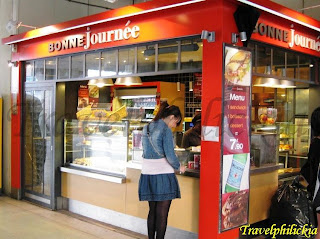

Basilique du Sacré-Cœur
Basilique du Sacré-Cœur, also known as Basilica of the Sacred Heart of Paris, is a Roman Catholic Church located at Montmartre district of Paris (left photo below). Construction began in 1875 and was finished in 1914. It was consecrated after the end of World War I in 1919. The ovoid dome (right photo below) is the second highest point in Paris, after the Eiffel Tower.
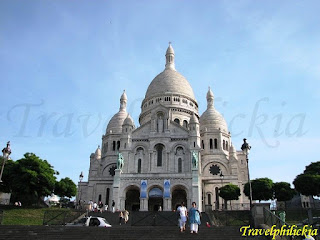

View of Paris skyline (left photo below) was great from the Basilica. At other part of the hill, the Eiffel Tower could be seen (right photo below).


The Great Mosaic of Christ, entitled Christ in Majesty, is one of the features inside the basilica (left photo below). Outside the basilica stood the Statue of Christ (right photo below). It is the basilica's most important statue that is symbolically placed above the two bronze saints. The Equestrian Statues consists of Saint Louis (bottom left photo) and Joan of Arc (bottom right photo).


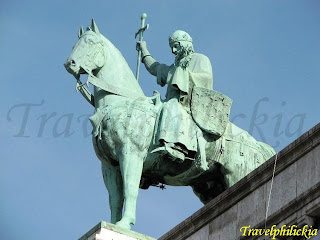

The façade of the basilica is decorated with many interesting gargoyles (photos below). Just need to be observant to spot them.


The nearest Metro is Abbesses station, then take the funiculaire or walk up the steps to the basilica. The opening hour of the basilica from 0600 hours to 2230 hours daily.
Place du Tertre
Place du Tertre is a square which is only a few streets away from Basilique du Sacré-Cœur. It is full of portraitists (photos below) who began exhibiting their paintings since 19th century.


Arc de Triomphe
The Arc de Triomphe, or Arc de Triomphe de l'Étoile in French, is one of the most famous monuments in Paris. Literally translated as Triumphal Arch, this monument honors those who fought and died for France during the French Revolutionary and Napoleonic Wars. Names of all French victories and generals were inscribed on the monument's inner and outer surfaces.
The arch stands at an impressive height of 50-meters, 45-meters by length and 22-meters deep (photos below).


Construction began in 1806 under the orders of Napoleon after his greatest victory, the Battle of Austerlitz. The arch only completed in 1836. Its design was inspired by the Roman Arch of Titus.
Many details have been incorporated into the design and construction of the arch; such as the detailed flowery pattern on the vault ceiling (left photo below). Six reliefs were sculpted on the façades of the Arch where each representing important moments of the French Revolution and of the Napoleonic era, such as the La prise d'Alexandrie, The Fall of Alexandria, on 3 July 1798 (right photo below).


The four sculptural groups at the base of the monument are La Paix de 1815 (left photo below), La Résistance de 1814 (right photo below), Le Triomphe de 1810 (bottom left photo) and the most renowned of them all, Departure of the Volunteers of 1792 (bottom right photo) commonly called La Marseillaise.




| 🛫 Travel Trivia |
|---|
| 'La Marseillaise', or 'Departure of the Volunteers of 1792', is the national anthem of France. It was written in 1792 by Claude Joseph Rouget de Lisle in Strasbourg after the declaration of war by France against Austria. The song acquired its nickname after being sung in Paris by volunteers from Marseille marching to the capital on 30 July 1792. The French National Convention adopted it as the First Republic's anthem in 1795.
|
The large vault measures 29.19-meters high and 14.62-meters wide (left photo below). Beneath the vault lies the Tomb of the Unknown Soldier from World War I (right photo below).


The Arc de Triomphe is accessible by the RER and Metro, with exit at the Charles de Gaulle-Étoile station. Due to the heavy traffic around the monument, it is recommended that visitors take one of two underpasses located at the Champs Élysées and the Avenue de la Grande Armée to reach there.
Champs-Élysées
One of the world's famous shopping streets, Avenue des Champs-Élysées has a length of 1.91-km from Arc de Triomphe to Place de la Concorde.
Probably the most famous luxury brand is Louis Vuitton, where its flagship store (photos below) is located near Arc de Triomphe along Champs-Élysées. Seems like its a dream of every LV fans to visit this flagship store. One observation was there seems to be many Chinese salesperson hired at this store just to serve the Chinese customers. Perhaps the buying power of PRC has increased so much that even the famous French brand has to adjust to this trend.


Other luxury brands include the French brand – Cartier (left photo below) and the Italian brand – Gucci (right photo below).


We spent about an hour in Louis Vuitton. After which we walked along Champs-Élysées, and had lunch inside one of the fast food restaurants which cost EUR 6.40. Due to the limited time, we only visited Gucci store.
At least 4 metro stations are located along Champs-Élysées, including Charles de Gaulle-Étoile station, George V station, Franklin D. Roosevelt station and Champs-Élysées Clemenceau station.
Grand Palais
The Grand Palais des Champs-Élysées, commonly known as the Grand Palais, is a large historic site, exhibition hall and museum complex located at the Champs-Élysées. The exterior of this massive palace combines an imposing classical stone façade with a riot of Art Nouveau ironwork.
The palace has colossal bronze statue of flying horses and chariots at its four corners (left photo below). The metal structure supporting the glass weighs 8,500-tonnes (right photo below), some 500-tones more than Eiffel Tower.


The nearest metro station is Champs-Élysées Clemenceau station.
Petit Palais
Directly opposite of Grand Palais, the Petit Palais (left photo below) was built for the Universal Exhibition in 1900 to stage a major display of French art, this jewel of a building now houses the Musée des Beaux-Arts de la Ville de Paris. The Palace has iconic columns, a grand porch (right photo below) and a dome, which echoes that of the Invalides.


The nearest metro station is Champs-Élysées Clemenceau station.
Les Invalides and Dôme Church
Beyond Pont Alexandre III bridge is Les Invalides and Dôme Church (left photo below). Also known as L'Hôtel national des Invalides, or literally The National Residence of the Invalids, Les Invalides is a complex of buildings in the 7th arrondissement of Paris. This building complex (right photo below) contains museums and monuments, all relating to the military history of France, as well as a hospital and a retirement home for war veterans which was the building's original purpose. The cupola of the Dôme church was gilded.


The most notable tomb at Les Invalides is that of Napoleon Bonaparte (1769–1821). Napoléon's ashes were first buried in the Chapelle Saint-Jérôme in the Invalides until his final resting place, a tomb in the Dôme Church, which was finished in 1861.
Due to our tight schedule, we didn't visit Les Invalides. The nearest Metro is Varenne station or La Tour-Maubourg sation.
Pont Alexandre III
This is the prettiest and most extravagant bridge in Paris (left photo below) with its exuberant Art Nouveau decoration of lamps, cherubs, nymphs of the Seine (right photo below) and winged horses at either end.
It was built between 1896 and 1900, in time for the Universal Exhibition and it was named after Tsar Alexander III (father of Nicholas II) who laid the foundation stone in Oct 1896.


Four gilt-bronze statues of Fames watch over the bridge, supported on massive 17-meter socles (left photo below), which provide stabilizing counterweight for the arch, without interfering with monumental views. The socles are crowned by Fames restraining Pegasus (right photo below).


The nearest metro station is Champs-Élysées Clemenceau station.
Palais Bourbon
The Palais Bourbon (left photo below) is a palace located on the left bank of the Seine, across from the Place de la Concorde. It is now the seat of the French National Assembly, the lower legislative chamber of the French government. The grand Roman portico (right photo below) was added to the Palais Bourbon in 1806 – 1808.


Place de la Concorde
This is one of Europe's most magnificent and historic squares, covering more than 8-hectares in the middle of Paris. It was built in the mid-18th century where an open octagon with only the north side containing mansions. It underwent a series of name changes in the nineteenth century, but the city eventually settled on the name Place de la Concorde.
Even the lamppost is decorated ornately (left photo below). The fountains are monumental to commemorate maritime, navigation, commerce and industry of France (right photo below). There are eight angles located at the octagonal Place, where each statue represents a French city, for example the statue of Lyon (bottom left photo). The highlight of the square is a giant Egyptian obelisk decorated with hieroglyphics exalting the reign of the pharaoh Ramses II. It is one of two obelisks the Egyptian government gave to the French in the nineteenth century (bottom right photo).



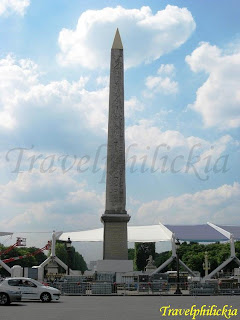
The nearest metro station is Concorde station.
Laduree
While walking towards Boulevard Haussmann, we saw this Laduree store (left photo below). It is known as the inventor of the double-decker macaron where almost 15,000 are sold every day. Laduree is considered to be the best makers of macarons in the world. To me it is rather a luxury snack where 125-grams can cost EUR 8.50 (right photo below).
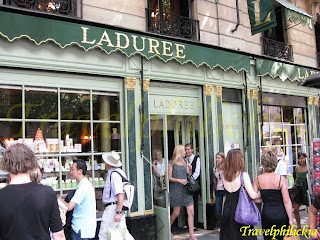

Galeries Lafayette
We finally reached our last shopping destination. Galeries Lafayette is a flagship 10-storey up-class department store located at 40 Boulevard Haussmann. The glass and steel dome, together with Art Nouveau staircases were built in 1912 (photos below).


Personally feel that this is the most ornate and lavish shopping mall I've seen (left photo below). Interestingly the Chinese name of Galeries Lafayette has been translated as '老佛爷百货' (right photo below).


After some searching inside the shopping mall, we decided to have our dinner at the Restaurant Sichuan (left photo below). Ordered a plate of 'fried Kway Teow' for myself (right photo below) and we shared other snacks and drinks. Ended up paying EUR 18 per person. Taste was good, especially to be able to have authentic Chinese food in Europe.


The nearest metro station is Chaussée d'Antin - La Fayette station, Havre-Caumartin station, Opéra station, Madeleine station, Saint-Lazare station, and RER – Auber station.
Hard Rock Café Paris
Before going to our final sight, we went to Hard Rock Café – Paris (left photo below) to get some souvenirs. The Hard Rock Cafe Paris is centrally located next to the Opera and the Grands Boulevards, not far from famous places such as Musée Grévin, les Etoiles du Rex or the Theather of Varietes. For me I only bought a shot-glass (right photo below).


The nearest metro station is Grands Boulevards station or Richelieu-Druot station, with about 10-mins walk from either station.
Eiffel Tower
Our last destination of the day: Eiffel Tower. Built in 1889, it has become both a global icon of France and one of the most recognizable structures in the world. The tower stands 324-metres tall, about the same height as an 81-storey building (photos below).


One advice is to pre-book the tickets from the official website as it will shorten the time and hassle needed to buy on the spot. However do note that visitors are not allowed to enter if the designated time selected by visitors themselves has passed.
As it was evening, golden rays from the setting sun coated the tower with orange-brown color. We were lucky that we were allowed to go to this express queue even though we were late for 5-mins. After which, all visitors are required to pass through a security check (left photo below). We then got onto an elevator (right photo below) where it will bring us to first level, second level and finally to the top or third level.


View of Paris skyline changes as we go higher up to the top.
There is a small kiosk that sells champagne to visitors at the third level, which definitely at a much higher price (left photo below). Directions and distance of various cities around the world can be found in the viewing platform. It seems like Singapore is rather far from Paris, almost 10,745-km away (right photo below).


From the third level, Paris skyline can be seen, such as buildings at Chaillot Hill (left photo below) and Pont de Grenelle where a smaller copy of Statue of Liberty is situated (right photo below).


We stayed quite long, more than half an hour, at the third level waiting for the sun to set (photos below).


And the bonus we got was to see the whole Paris got lighted up (photos below). Famous buildings we saw included the illuminated Dôme Church (bottom left photo) and Arc de Triomphe (bottom right photo).




Of course, the Eiffel Tower itself was illuminated with many light bulbs and the effect was stunning (photos below).

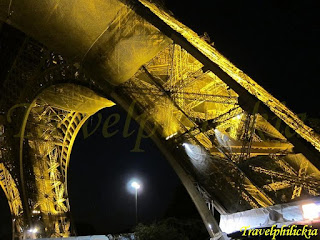


The cost to reach the third or highest level of the tower was EUR 13.10 via online booking, and its opening hours from 0900 hours to 1245 hours (17 jun to 28 Aug) or 0930 hours to 1145 hours (rest of the year). The nearest RER station is Champs de Mars - Tour Eiffel station.
After which we took the RER then Metro back to the hotel, and had a good rest.
 Posts RSS
Posts RSS


